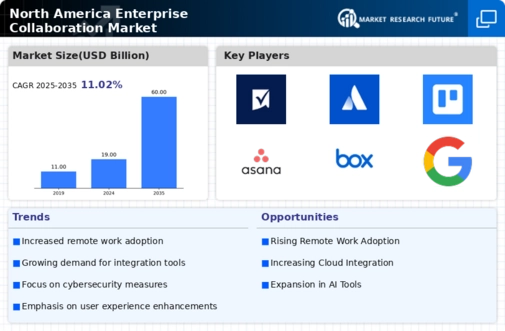The North America Enterprise Collaboration Market has evolved significantly, driven by the increasing need for streamlined communication and productivity among organizations. This market is characterized by a plethora of players offering diverse solutions aimed at enhancing collaboration, project management, and overall workplace efficiency. As companies adapt to hybrid work models and strive for digital transformation, the competitive landscape has intensified, with both established firms and emerging startups leveraging technology to provide innovative tools.
The market insights reveal crucial trends, such as the integration of artificial intelligence and real-time collaboration features, which are reshaping user experiences and driving greater adoption across various sectors. Furthermore, companies are focusing on creating user-friendly interfaces and seamless integrations with existing tools to enhance value propositions, leading to a more competitive environment.In the North America enterprise collaboration market, Smartsheet stands out with its robust platform designed for project management and team collaboration.
The company has made significant strides by offering a versatile solution that combines task management, automation, and reporting features, making it an essential tool for teams across various industries. Smartsheet's strengths lie in its user-centric approach, which allows users to customize workflows and manage projects effectively. Additionally, its strong presence in North America is supported by extensive partnerships and integrations with other top-tier applications, thus enhancing its scalability.
The company's focus on providing training resources and exceptional customer support further solidifies Smartsheet's position as a preferred choice for organizations aiming to improve collaboration and drive efficiency.Atlassian maintains a noteworthy presence in the North America enterprise collaboration market, known for its flagship products such as Jira and Confluence. These tools are widely utilized for software development, collaboration, and documentation management, respectively, catering to the needs of both development teams and broader organizational workflows. Atlassian’s strengths include its strong market reputation, extensive ecosystem of third-party integrations, and a commitment to fostering community engagement through user forums and events.
The company has grown its footprint in North America through strategic acquisitions that enhance its product offerings, such as the integration of collaboration features in its tools. Furthermore, Atlassian's ability to adapt its solutions to meet the demands of remote and hybrid work environments has positioned it as a vital player in the market. The company’s innovative approach to continuous improvement ensures that it remains competitive and responsive to the evolving collaboration needs of its North American clientele.























Leave a Comment